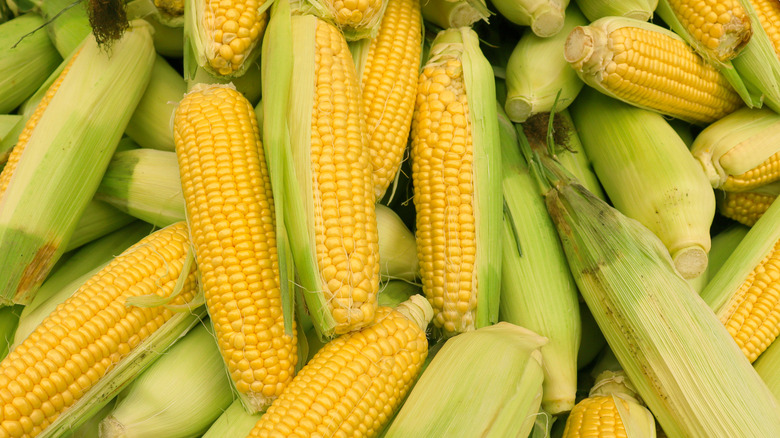Yellow Corn Isn't Sweeter Than White Corn – But There Is A Difference
It's my second summer in Iowa and nothing is more hotly anticipated than corn season. Walk through any grocery store or farmers market in peak summer, and you'll see husk-wrapped corn piled high in bins at recession-friendly prices. To the untrained eye, yellow and white corn look nearly identical (except for the color of kernels), but is there a real difference beyond appearance? The short answer is kind of, but it's subtle — and it comes down to personal taste and the ways you cook your corn on the cob.
The most obvious difference is right in the name and appearance. White corn has pale, ivory kernels, while yellow corn boasts bright golden ones. Similar to carrots, yellow corn contains beta-carotene, which the body converts into vitamin A. White corn, by contrast, doesn't have those pigments.
In terms of flavor, both types of corn can be sweet, because more than 90% of the corn sold in stores fall under the "sweet corn" variety, which is bred specifically for fresh eating. Subtleties do exist, but you might need the palate of an Iowan farmer to discern the differences. White corn can be slightly more delicate and mild. Yellow corn is typically a bit more robust, which holds up well to grilling and canning. More importantly, flavor varies depending on the variety and growing conditions, so it's not a hard-and-fast rule. It really depends on the season, soil, and how long the corn has been off the stalk.
Both yellow and white corn are sweet varieties
It's likely you'll see corn with both white and yellow kernels on the same cob; this is bicolor corn, sometimes sold as "butter and sugar" corn. Bicolor varieties are incredibly popular in the U.S. and are a favorite for summer grilling. But the corn we buy today looks so much different from its ancient beginnings, thousands of years ago. It even looked different several decades ago, when most of the corn grown for eating was yellow and less sweet. Thanks to a whole bunch of modern farming techniques and cross-pollinating, pretty much all the corn you buy at stores or farmers markets is going to be sweet and tender.
What's most important is how fresh the corn is, and exactly how you store fresh ears of sweet corn. Keep those protective husks on to lock in moisture, use the crisper drawer in your fridge to control humidity, and cook your corn as soon as possible. Corn begins to lose its sweetness the minute it leaves the field. At the end of the day, the difference between white and yellow corn isn't drastic. Sure, there's a tiny nutritional edge with yellow corn's beta-carotene, but you'd have to eat a whole bushel for that to really matter. Both varieties of corn are delicious, and at peak freshness, either will be a summer showstopper.

